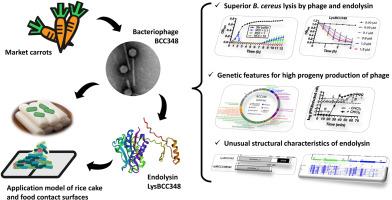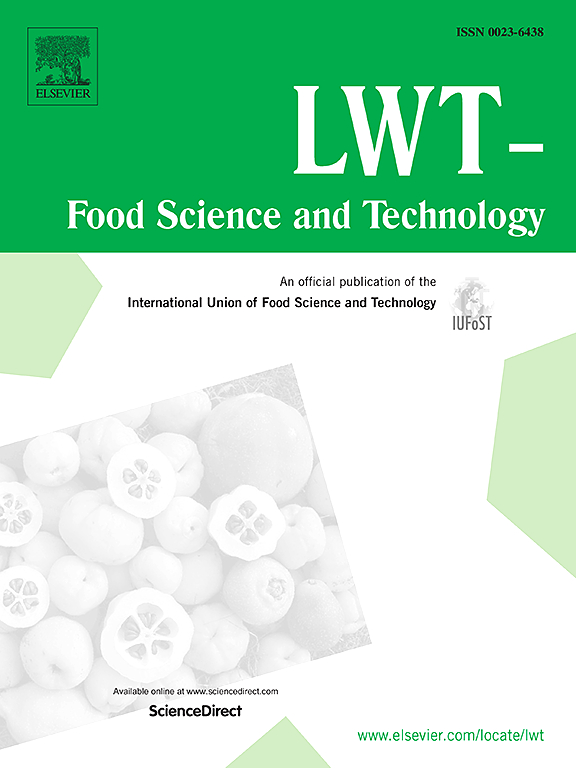Control of Bacillus cereus in rice cake and food contact surfaces with novel Becedseptimavirus genus phage BCC348 and its partial SPOR domain-containing endolysin LysBCC348
IF 6
1区 农林科学
Q1 FOOD SCIENCE & TECHNOLOGY
引用次数: 0
Abstract
Here, we investigated the novel bacteriophage BCC348 and its endolysin LysBCC348 as alternative antimicrobials against the major foodborne pathogen Bacillus cereus. The Becedseptimavirus genus phage BCC348 effectively inhibited the growth of B. cereus ATCC 27348 with a remarkable burst size of ∼600 PFU/infected cell. The cation-dependent amidase endolysin LysBCC348 lysed the host B. cereus and Listeria monocytogenes and EDTA-treated Gram-negative pathogens. In a cold storage model of Korean rice cake, Garaetteok, BCC348 significantly reduced artificially contaminated B. cereus counts to undetectable levels within 3 days. Treatment with LysBCC348 also achieved a ∼1.3-log reduction of B. cereus and ∼60% biofilm removal from food contact surfaces. Genes related to DNA modification and sporulation prevention in BCC348, as well as a partial sporulation-related repeat (SPOR) domain in LysBCC348, are thought to enhance the efficacy of BCC348 in controlling B. cereus. These results suggest that BCC348 and LysBCC348 are promising alternative candidates to mitigate B. cereus contamination in the food industry.

用新型贝塞病毒属噬菌体 BCC348 及其部分含 SPOR 结构域的内溶素 LysBCC348 控制年糕和食品接触表面中的蜡样芽孢杆菌
在此,我们研究了新型噬菌体 BCC348 及其内溶菌素 LysBCC348 作为替代抗菌剂对主要食源性病原体蜡样芽孢杆菌的作用。噬菌体 BCC348 能有效抑制蜡样芽孢杆菌(B. cereus ATCC 27348)的生长,其迸发量可达 600 PFU/感染细胞。阳离子依赖性酰胺酶内溶酶 LysBCC348 能裂解宿主蜡样芽孢杆菌、单核细胞增生李斯特菌和经 EDTA 处理的革兰氏阴性病原体。在韩国年糕 Garaetteok 的冷藏模型中,BCC348 能在 3 天内将人工污染的蜡样芽孢杆菌数量显著降至检测不到的水平。用 LysBCC348 处理后,蜡样芽孢杆菌的数量也减少了 1.3 个菌落,食品接触表面的生物膜去除率达到 60%。BCC348 中与 DNA 修饰和孢子化预防有关的基因以及 LysBCC348 中的部分孢子化相关重复(SPOR)结构域被认为可提高 BCC348 在控制蜡样芽孢杆菌方面的功效。这些结果表明,BCC348 和 LysBCC348 有希望成为减轻食品工业中蜡样芽孢杆菌污染的替代候选物。
本文章由计算机程序翻译,如有差异,请以英文原文为准。
求助全文
约1分钟内获得全文
求助全文
来源期刊

LWT - Food Science and Technology
工程技术-食品科技
CiteScore
11.80
自引率
6.70%
发文量
1724
审稿时长
65 days
期刊介绍:
LWT - Food Science and Technology is an international journal that publishes innovative papers in the fields of food chemistry, biochemistry, microbiology, technology and nutrition. The work described should be innovative either in the approach or in the methods used. The significance of the results either for the science community or for the food industry must also be specified. Contributions written in English are welcomed in the form of review articles, short reviews, research papers, and research notes. Papers featuring animal trials and cell cultures are outside the scope of the journal and will not be considered for publication.
 求助内容:
求助内容: 应助结果提醒方式:
应助结果提醒方式:


